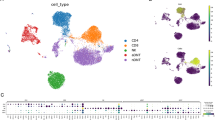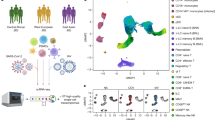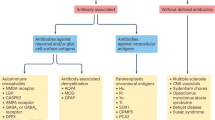Abstract
Here we describe a previously unknown form of inherited immunodeficiency revealed by an N-ethyl-N-nitrosourea–induced mutation called elektra. Mice homozygous for this mutation showed enhanced susceptibility to bacterial and viral infection and diminished numbers of T cells and inflammatory monocytes that failed to proliferate after infection and died via the intrinsic apoptotic pathway in response to diverse proliferative stimuli. They also had a greater proportion of T cells poised to replicate DNA, and their T cells expressed a subset of activation markers, suggestive of a semi-activated state. We positionally ascribe the elektra phenotype to a mutation in the gene encoding Schlafen-2 (Slfn2). Our findings identify a physiological role for Slfn2 in the defense against pathogens through the regulation of quiescence in T cells and monocytes.
This is a preview of subscription content, access via your institution
Access options
Subscribe to this journal
Receive 12 print issues and online access
$259.00 per year
only $21.58 per issue
Buy this article
- Purchase on SpringerLink
- Instant access to full article PDF
Prices may be subject to local taxes which are calculated during checkout








Similar content being viewed by others
References
Yusuf, I. & Fruman, D.A. Regulation of quiescence in lymphocytes. Trends Immunol. 24, 380–386 (2003).
Chechlinska, M. et al. Molecular signature of cell cycle exit induced in human T lymphoblasts by IL-2 withdrawal. BMC Genomics 10, 261 (2009).
Coller, H.A., Sang, L. & Roberts, J.M. A new description of cellular quiescence. PLoS Biol. 4, e83 (2006).
Glynne, R., Ghandour, G., Rayner, J., Mack, D.H. & Goodnow, C.C. B-lymphocyte quiescence, tolerance and activation as viewed by global gene expression profiling on microarrays. Immunol. Rev. 176, 216–246 (2000).
Teague, T.K. et al. Activation changes the spectrum but not the diversity of genes expressed by T cells. Proc. Natl. Acad. Sci. USA 96, 12691–12696 (1999).
Tothova, Z. et al. FoxOs are critical mediators of hematopoietic stem cell resistance to physiologic oxidative stress. Cell 128, 325–339 (2007).
Kuo, C.T., Veselits, M.L. & Leiden, J.M. LKLF: A transcriptional regulator of single-positive T cell quiescence and survival. Science 277, 1986–1990 (1997).
Tzachanis, D. et al. Tob is a negative regulator of activation that is expressed in anergic and quiescent T cells. Nat. Immunol. 2, 1174–1182 (2001).
Crozat, K. et al. Analysis of the MCMV resistome by ENU mutagenesis. Mamm. Genome 17, 398–406 (2006).
Webb, J.R., Lee, S.H. & Vidal, S.M. Genetic control of innate immune responses against cytomegalovirus: MCMV meets its match 3. Genes Immun. 3, 250–262 (2002).
Jiang, Z. et al. Details of Toll-like receptor:adapter interaction revealed by germ-line mutagenesis. Proc. Natl. Acad. Sci. USA 103, 10961–10966 (2006).
Macian, F. NFAT proteins: key regulators of T-cell development and function. Nat. Rev. Immunol. 5, 472–484 (2005).
Li, Q. & Verma, I.M. NF-κB regulation in the immune system. Nat. Rev. Immunol. 2, 725–734 (2002).
Juntilla, M.M. & Koretzky, G.A. Critical roles of the PI3K/Akt signaling pathway in T cell development. Immunol. Lett. 116, 104–110 (2008).
Wada, T. & Penninger, J.M. Mitogen-activated protein kinases in apoptosis regulation. Oncogene 23, 2838–2849 (2004).
Rincon, M. & Pedraza-Alva, G. JNK and p38 MAP kinases in CD4+ and CD8+ T cells. Immunol. Rev. 192, 131–142 (2003).
Boyman, O., Ramsey, C., Kim, D.M., Sprent, J. & Surh, C.D. IL-7/anti-IL-7 mAb complexes restore T cell development and induce homeostatic T cell expansion without lymphopenia. J. Immunol. 180, 7265–7275 (2008).
Kieper, W.C. & Jameson, S.C. Homeostatic expansion and phenotypic conversion of naive T cells in response to self peptide/MHC ligands. Proc. Natl. Acad. Sci. USA 96, 13306–13311 (1999).
Goldrath, A.W., Bogatzki, L.Y. & Bevan, M.J. Naive T cells transiently acquire a memory-like phenotype during homeostasis-driven proliferation. J. Exp. Med. 192, 557–564 (2000).
Cho, B.K., Rao, V.P., Ge, Q., Eisen, H.N. & Chen, J. Homeostasis-stimulated proliferation drives naive T cells to differentiate directly into memory T cells. J. Exp. Med. 192, 549–556 (2000).
Khaled, A.R. & Durum, S.K. Lymphocide: cytokines and the control of lymphoid homeostasis. Nat. Rev. Immunol. 2, 817–830 (2002).
Hildeman, D.A. et al. Activated T cell death in vivo mediated by proapoptotic bcl-2 family member bim. Immunity 16, 759–767 (2002).
Pellegrini, M., Belz, G., Bouillet, P. & Strasser, A. Shutdown of an acute T cell immune response to viral infection is mediated by the proapoptotic Bcl-2 homology 3-only protein Bim. Proc. Natl. Acad. Sci. USA 100, 14175–14180 (2003).
Krammer, P.H., Arnold, R. & Lavrik, I.N. Life and death in peripheral T cells. Nat. Rev. Immunol. 7, 532–542 (2007).
Boyman, O., Cho, J.H., Tan, J.T., Surh, C.D. & Sprent, J. A major histocompatibility complex class I-dependent subset of memory phenotype CD8+ cells. J. Exp. Med. 203, 1817–1825 (2006).
Oehen, S. & Brduscha-Riem, K. Differentiation of naive CTL to effector and memory CTL: correlation of effector function with phenotype and cell division. J. Immunol. 161, 5338–5346 (1998).
Chao, C.C., Jensen, R. & Dailey, M.O. Mechanisms of L-selectin regulation by activated T cells. J. Immunol. 159, 1686–1694 (1997).
Serbina, N.V. et al. Sequential MyD88-independent and -dependent activation of innate immune responses to intracellular bacterial infection. Immunity 19, 891–901 (2003).
Schwarz, D.A., Katayama, C.D. & Hedrick, S.M. Schlafen, a new family of growth regulatory genes that affect thymocyte development. Immunity 9, 657–668 (1998).
Dooms, H. et al. Quiescence-inducing and antiapoptotic activities of IL-15 enhance secondary CD4+ T cell responsiveness to antigen. J. Immunol. 161, 2141–2150 (1998).
Buckley, A.F., Kuo, C.T. & Leiden, J.M. Transcription factor LKLF is sufficient to program T cell quiescence via a c-Myc–dependent pathway. Nat. Immunol. 2, 698–704 (2001).
Bai, A., Hu, H., Yeung, M. & Chen, J. Kruppel-like factor 2 controls T cell trafficking by activating L-selectin (CD62L) and sphingosine-1-phosphate receptor 1 transcription. J. Immunol. 178, 7632–7639 (2007).
Carlson, C.M. et al. Kruppel-like factor 2 regulates thymocyte and T-cell migration. Nature 442, 299–302 (2006).
Kerdiles, Y.M. et al. Foxo1 links homing and survival of naive T cells by regulating L-selectin, CCR7 and interleukin 7 receptor. Nat. Immunol. 10, 176–184 (2009).
Geserick, P., Kaiser, F., Klemm, U., Kaufmann, S.H. & Zerrahn, J. Modulation of T cell development and activation by novel members of the Schlafen (slfn) gene family harbouring an RNA helicase-like motif. Int. Immunol. 16, 1535–1548 (2004).
Ferguson, D.A., Chiang, J.T., Richardson, J.A. & Graff, J. eXPRESSION: an in silico tool to predict patterns of gene expression. Gene Expr. Patterns 5, 619–628 (2005).
Hanson, P.I. & Whiteheart, S.W. AAA+ proteins: have engine, will work. Nat. Rev. Mol. Cell Biol. 6, 519–529 (2005).
White, S.R. & Lauring, B. AAA+ ATPases: achieving diversity of function with conserved machinery. Traffic 8, 1657–1667 (2007).
Brady, G., Boggan, L., Bowie, A. & O'Neill, L.A. Schlafen-1 causes a cell cycle arrest by inhibiting induction of cyclin D1. J. Biol. Chem. 280, 30723–30734 (2005).
Kaufmann, A. et al. Defense against influenza A virus infection: essential role of the chemokine system. Immunobiology 204, 603–613 (2001).
Barbalat, R., Lau, L., Locksley, R.M. & Barton, G.M. Toll-like receptor 2 on inflammatory monocytes induces type I interferon in response to viral but not bacterial ligands. Nat. Immunol. 10, 1200–1207 (2009).
Gubser, C. et al. Camelpox virus encodes a schlafen-like protein that affects orthopoxvirus virulence. J. Gen. Virol. 88, 1667–1676 (2007).
Hoebe, K., Du, X., Goode, J., Mann, N. & Beutler, B. Lps2: a new locus required for responses to lipopolysaccharide, revealed by germline mutagenesis and phenotypic screening. J. Endotoxin Res. 9, 250–255 (2003).
Rutschmann, S. et al. PanR1, a dominant negative missense allele of the gene encoding TNF-α (Tnf), does not impair lymphoid development. J. Immunol. 176, 7525–7532 (2006).
Krebs, P. et al. NK-cell-mediated killing of target cells triggers robust antigen-specific T-cell-mediated and humoral responses. Blood 113, 6593–6602 (2009).
Reeves, J.P., Reeves, P.A. and Chin, L.T. in Current Protocols in Immunology (eds. Coligan, J.E. et al.) 1.10.5–1.10.6 (John Wiley & Sons, Hoboken, New Jersey, 2009).
Acknowledgements
We thank O. Milstein, J.F. Purton and K. Brandl for discussions; M.B.A. Oldstone (The Scripps Research Institute) for the Armstrong strain of LCMV; and C.D. Surh (The Scripps Research Institute) for monoclonal anti-IL-7 (M25). Supported by the European Molecular Biology Organization (M.B. and P.K.), the Swiss National Science Foundation (P.K.) and the US National Institutes of Health (PO1 AI070167-01).
Author information
Authors and Affiliations
Contributions
M.B. and B.B. designed the research with critical suggestions from P.K., K.C. and A.N.T.; M.B., P.K., K.C., X.L., B.A.C., O.M.S., D.P. and B.R.L. did experiments; X.L. and X.D. generated the BAC-transgenic mice; M.B., Y.X. and K.K. did all genome mapping; T.S., O.T. and S.A. generated Slfn3−/− and Slfn1−/− mice; and M.B., E.M.Y.M. and B.B. wrote the manuscript.
Corresponding author
Ethics declarations
Competing interests
The authors declare no competing financial interests.
Supplementary information
Supplementary Text and Figures
Supplementary Figures 1–7 (PDF 3841 kb)
Rights and permissions
About this article
Cite this article
Berger, M., Krebs, P., Crozat, K. et al. An Slfn2 mutation causes lymphoid and myeloid immunodeficiency due to loss of immune cell quiescence. Nat Immunol 11, 335–343 (2010). https://doi.org/10.1038/ni.1847
Received:
Accepted:
Published:
Issue date:
DOI: https://doi.org/10.1038/ni.1847
This article is cited by
-
Human SLFN5 and its Xenopus Laevis ortholog regulate entry into mitosis and oocyte meiotic resumption
Cell Death Discovery (2022)
-
An alkaloid initiates phosphodiesterase 3A–schlafen 12 dependent apoptosis without affecting the phosphodiesterase activity
Nature Communications (2020)
-
Schlafen2 mutation in mice causes an osteopetrotic phenotype due to a decrease in the number of osteoclast progenitors
Scientific Reports (2018)
-
Structure of Schlafen13 reveals a new class of tRNA/rRNA- targeting RNase engaged in translational control
Nature Communications (2018)
-
Codon-usage-based inhibition of HIV protein synthesis by human schlafen 11
Nature (2012)



